[English] 日本語
 Yorodumi
Yorodumi- PDB-5fwy: Crystal structure of the AMPA receptor GluA2/A3 N-terminal domain... -
+ Open data
Open data
- Basic information
Basic information
| Entry | Database: PDB / ID: 5fwy | ||||||
|---|---|---|---|---|---|---|---|
| Title | Crystal structure of the AMPA receptor GluA2/A3 N-terminal domain heterodimer | ||||||
 Components Components | (GLUTAMATE RECEPTOR ...) x 2 | ||||||
 Keywords Keywords | TRANSPORT PROTEIN | ||||||
| Function / homology |  Function and homology information Function and homology informationTrafficking of AMPA receptors / Synaptic adhesion-like molecules / spine synapse / dendritic spine neck / dendritic spine head / protein heterotetramerization / cellular response to amine stimulus / perisynaptic space / Activation of AMPA receptors / parallel fiber to Purkinje cell synapse ...Trafficking of AMPA receptors / Synaptic adhesion-like molecules / spine synapse / dendritic spine neck / dendritic spine head / protein heterotetramerization / cellular response to amine stimulus / perisynaptic space / Activation of AMPA receptors / parallel fiber to Purkinje cell synapse / ligand-gated monoatomic cation channel activity / AMPA glutamate receptor activity / response to lithium ion / Trafficking of GluR2-containing AMPA receptors / kainate selective glutamate receptor activity / AMPA glutamate receptor complex / cellular response to glycine / extracellularly glutamate-gated ion channel activity / immunoglobulin binding / asymmetric synapse / ionotropic glutamate receptor complex / conditioned place preference / regulation of receptor recycling / glutamate receptor binding / Unblocking of NMDA receptors, glutamate binding and activation / positive regulation of synaptic transmission / synaptic cleft / regulation of synaptic transmission, glutamatergic / response to fungicide / cytoskeletal protein binding / glutamate-gated receptor activity / regulation of long-term synaptic depression / extracellular ligand-gated monoatomic ion channel activity / cellular response to brain-derived neurotrophic factor stimulus / presynaptic active zone membrane / glutamate-gated calcium ion channel activity / somatodendritic compartment / dendrite membrane / ionotropic glutamate receptor binding / ligand-gated monoatomic ion channel activity involved in regulation of presynaptic membrane potential / ionotropic glutamate receptor signaling pathway / dendrite cytoplasm / synaptic membrane / dendritic shaft / SNARE binding / transmitter-gated monoatomic ion channel activity involved in regulation of postsynaptic membrane potential / synaptic transmission, glutamatergic / PDZ domain binding / protein tetramerization / establishment of protein localization / postsynaptic density membrane / cerebral cortex development / modulation of chemical synaptic transmission / receptor internalization / Schaffer collateral - CA1 synapse / long-term synaptic potentiation / terminal bouton / synaptic vesicle / synaptic vesicle membrane / presynapse / signaling receptor activity / amyloid-beta binding / presynaptic membrane / growth cone / scaffold protein binding / perikaryon / protein homotetramerization / chemical synaptic transmission / dendritic spine / postsynaptic membrane / neuron projection / postsynaptic density / axon / external side of plasma membrane / neuronal cell body / dendrite / synapse / protein kinase binding / protein-containing complex binding / glutamatergic synapse / cell surface / endoplasmic reticulum / protein-containing complex / identical protein binding / membrane / plasma membrane Similarity search - Function | ||||||
| Biological species |  | ||||||
| Method |  X-RAY DIFFRACTION / X-RAY DIFFRACTION /  SYNCHROTRON / SYNCHROTRON /  MOLECULAR REPLACEMENT / Resolution: 2.12 Å MOLECULAR REPLACEMENT / Resolution: 2.12 Å | ||||||
 Authors Authors | Herguedas, B. / Garcia-Nafria, J. / Greger, I.H. | ||||||
 Citation Citation |  Journal: Science / Year: 2016 Journal: Science / Year: 2016Title: Structure and organization of heteromeric AMPA-type glutamate receptors. Authors: Beatriz Herguedas / Javier García-Nafría / Ondrej Cais / Rafael Fernández-Leiro / James Krieger / Hinze Ho / Ingo H Greger /  Abstract: AMPA-type glutamate receptors (AMPARs), which are central mediators of rapid neurotransmission and synaptic plasticity, predominantly exist as heteromers of the subunits GluA1 to GluA4. Here we ...AMPA-type glutamate receptors (AMPARs), which are central mediators of rapid neurotransmission and synaptic plasticity, predominantly exist as heteromers of the subunits GluA1 to GluA4. Here we report the first AMPAR heteromer structures, which deviate substantially from existing GluA2 homomer structures. Crystal structures of the GluA2/3 and GluA2/4 N-terminal domains reveal a novel compact conformation with an alternating arrangement of the four subunits around a central axis. This organization is confirmed by cysteine cross-linking in full-length receptors, and it permitted us to determine the structure of an intact GluA2/3 receptor by cryogenic electron microscopy. Two models in the ligand-free state, at resolutions of 8.25 and 10.3 angstroms, exhibit substantial vertical compression and close associations between domain layers, reminiscent of N-methyl-D-aspartate receptors. Model 1 resembles a resting state and model 2 a desensitized state, thus providing snapshots of gating transitions in the nominal absence of ligand. Our data reveal organizational features of heteromeric AMPARs and provide a framework to decipher AMPAR architecture and signaling. | ||||||
| History |
|
- Structure visualization
Structure visualization
| Structure viewer | Molecule:  Molmil Molmil Jmol/JSmol Jmol/JSmol |
|---|
- Downloads & links
Downloads & links
- Download
Download
| PDBx/mmCIF format |  5fwy.cif.gz 5fwy.cif.gz | 594 KB | Display |  PDBx/mmCIF format PDBx/mmCIF format |
|---|---|---|---|---|
| PDB format |  pdb5fwy.ent.gz pdb5fwy.ent.gz | 491.9 KB | Display |  PDB format PDB format |
| PDBx/mmJSON format |  5fwy.json.gz 5fwy.json.gz | Tree view |  PDBx/mmJSON format PDBx/mmJSON format | |
| Others |  Other downloads Other downloads |
-Validation report
| Summary document |  5fwy_validation.pdf.gz 5fwy_validation.pdf.gz | 496.8 KB | Display |  wwPDB validaton report wwPDB validaton report |
|---|---|---|---|---|
| Full document |  5fwy_full_validation.pdf.gz 5fwy_full_validation.pdf.gz | 507.8 KB | Display | |
| Data in XML |  5fwy_validation.xml.gz 5fwy_validation.xml.gz | 55.2 KB | Display | |
| Data in CIF |  5fwy_validation.cif.gz 5fwy_validation.cif.gz | 77.1 KB | Display | |
| Arichive directory |  https://data.pdbj.org/pub/pdb/validation_reports/fw/5fwy https://data.pdbj.org/pub/pdb/validation_reports/fw/5fwy ftp://data.pdbj.org/pub/pdb/validation_reports/fw/5fwy ftp://data.pdbj.org/pub/pdb/validation_reports/fw/5fwy | HTTPS FTP |
-Related structure data
| Related structure data |  8090C  8091C  5fwxC  5ideC  5idfC  3hsyS  3o21S S: Starting model for refinement C: citing same article ( |
|---|---|
| Similar structure data |
- Links
Links
- Assembly
Assembly
| Deposited unit | 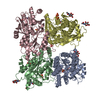
| ||||||||
|---|---|---|---|---|---|---|---|---|---|
| 1 | 
| ||||||||
| 2 | 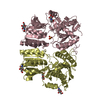
| ||||||||
| Unit cell |
|
- Components
Components
-GLUTAMATE RECEPTOR ... , 2 types, 4 molecules ACBD
| #1: Protein | Mass: 43731.359 Da / Num. of mol.: 2 / Fragment: RESIDUES 25-400 Source method: isolated from a genetically manipulated source Source: (gene. exp.)   HOMO SAPIENS (human) / References: UniProt: P19491 HOMO SAPIENS (human) / References: UniProt: P19491#2: Protein | Mass: 45093.953 Da / Num. of mol.: 2 / Fragment: RESIDUES 23-403 Source method: isolated from a genetically manipulated source Source: (gene. exp.)   HOMO SAPIENS (human) / References: UniProt: P19492 HOMO SAPIENS (human) / References: UniProt: P19492 |
|---|
-Sugars , 1 types, 10 molecules 
| #3: Sugar | ChemComp-NAG / |
|---|
-Non-polymers , 3 types, 361 molecules 




| #4: Chemical | ChemComp-SO4 / #5: Chemical | ChemComp-GOL / | #6: Water | ChemComp-HOH / | |
|---|
-Details
| Has protein modification | Y |
|---|
-Experimental details
-Experiment
| Experiment | Method:  X-RAY DIFFRACTION / Number of used crystals: 1 X-RAY DIFFRACTION / Number of used crystals: 1 |
|---|
- Sample preparation
Sample preparation
| Crystal | Density Matthews: 2.81 Å3/Da / Density % sol: 56.18 % / Description: NONE |
|---|---|
| Crystal grow | Details: 14-16 % PEG 3350, 0.27 M AMMONIUM SULPHATE AND 0.1 M BICINE PH 9 |
-Data collection
| Diffraction | Mean temperature: 100 K |
|---|---|
| Diffraction source | Source:  SYNCHROTRON / Site: SYNCHROTRON / Site:  Diamond Diamond  / Beamline: I04-1 / Wavelength: 0.92 / Beamline: I04-1 / Wavelength: 0.92 |
| Detector | Type: DECTRIS PIXEL / Detector: PIXEL / Date: Dec 9, 2012 |
| Radiation | Protocol: SINGLE WAVELENGTH / Monochromatic (M) / Laue (L): M / Scattering type: x-ray |
| Radiation wavelength | Wavelength: 0.92 Å / Relative weight: 1 |
| Reflection | Resolution: 2.12→41.75 Å / Num. obs: 100269 / % possible obs: 90.4 % / Observed criterion σ(I): 2 / Redundancy: 1.9 % / Rmerge(I) obs: 0.1 / Net I/σ(I): 6 |
| Reflection shell | Resolution: 2.12→2.18 Å / Redundancy: 1.9 % / Rmerge(I) obs: 0.44 / Mean I/σ(I) obs: 1.9 / % possible all: 87.8 |
- Processing
Processing
| Software |
| ||||||||||||||||||||||||||||||||||||||||||||||||||||||||||||||||||||||||||||||||||||||||||||||||||||||||||||||||||||||||||||||||||||||||||||||||||||||||||||||||||||||||||||||||||||||
|---|---|---|---|---|---|---|---|---|---|---|---|---|---|---|---|---|---|---|---|---|---|---|---|---|---|---|---|---|---|---|---|---|---|---|---|---|---|---|---|---|---|---|---|---|---|---|---|---|---|---|---|---|---|---|---|---|---|---|---|---|---|---|---|---|---|---|---|---|---|---|---|---|---|---|---|---|---|---|---|---|---|---|---|---|---|---|---|---|---|---|---|---|---|---|---|---|---|---|---|---|---|---|---|---|---|---|---|---|---|---|---|---|---|---|---|---|---|---|---|---|---|---|---|---|---|---|---|---|---|---|---|---|---|---|---|---|---|---|---|---|---|---|---|---|---|---|---|---|---|---|---|---|---|---|---|---|---|---|---|---|---|---|---|---|---|---|---|---|---|---|---|---|---|---|---|---|---|---|---|---|---|---|---|
| Refinement | Method to determine structure:  MOLECULAR REPLACEMENT MOLECULAR REPLACEMENTStarting model: PDB ENTRIES 3HSY AND 3O21 Resolution: 2.12→41.76 Å / Cor.coef. Fo:Fc: 0.952 / Cor.coef. Fo:Fc free: 0.929 / SU B: 12.006 / SU ML: 0.15 / Cross valid method: THROUGHOUT / ESU R: 0.226 / ESU R Free: 0.187 / Stereochemistry target values: MAXIMUM LIKELIHOOD Details: HYDROGENS HAVE BEEN ADDED IN THE RIDING POSITIONS. HYDROGENS HAVE BEEN ADDED IN THE RIDING POSITIONS U VALUES WITH TLS ADDED
| ||||||||||||||||||||||||||||||||||||||||||||||||||||||||||||||||||||||||||||||||||||||||||||||||||||||||||||||||||||||||||||||||||||||||||||||||||||||||||||||||||||||||||||||||||||||
| Solvent computation | Ion probe radii: 0.8 Å / Shrinkage radii: 0.8 Å / VDW probe radii: 1.2 Å / Solvent model: MASK | ||||||||||||||||||||||||||||||||||||||||||||||||||||||||||||||||||||||||||||||||||||||||||||||||||||||||||||||||||||||||||||||||||||||||||||||||||||||||||||||||||||||||||||||||||||||
| Displacement parameters | Biso mean: 39.088 Å2
| ||||||||||||||||||||||||||||||||||||||||||||||||||||||||||||||||||||||||||||||||||||||||||||||||||||||||||||||||||||||||||||||||||||||||||||||||||||||||||||||||||||||||||||||||||||||
| Refinement step | Cycle: LAST / Resolution: 2.12→41.76 Å
| ||||||||||||||||||||||||||||||||||||||||||||||||||||||||||||||||||||||||||||||||||||||||||||||||||||||||||||||||||||||||||||||||||||||||||||||||||||||||||||||||||||||||||||||||||||||
| Refine LS restraints |
|
 Movie
Movie Controller
Controller







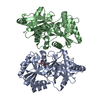


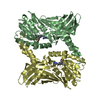
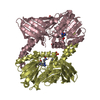
 PDBj
PDBj






